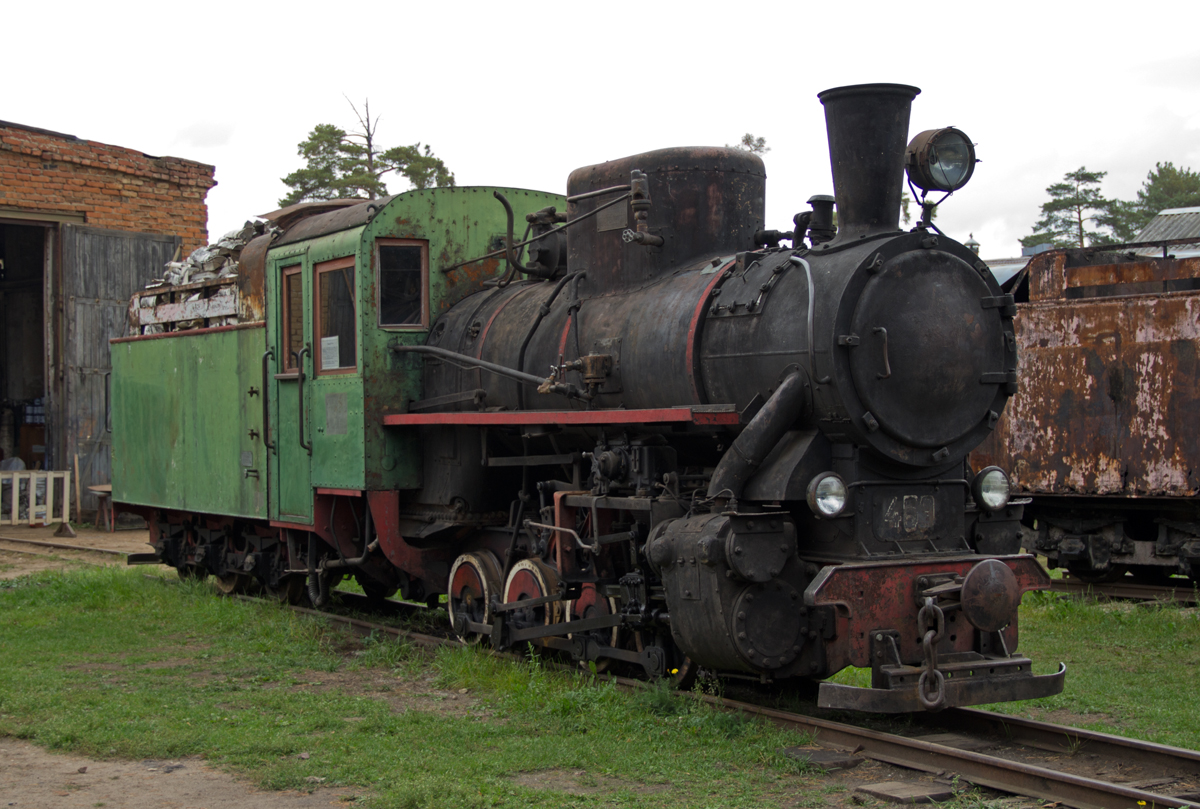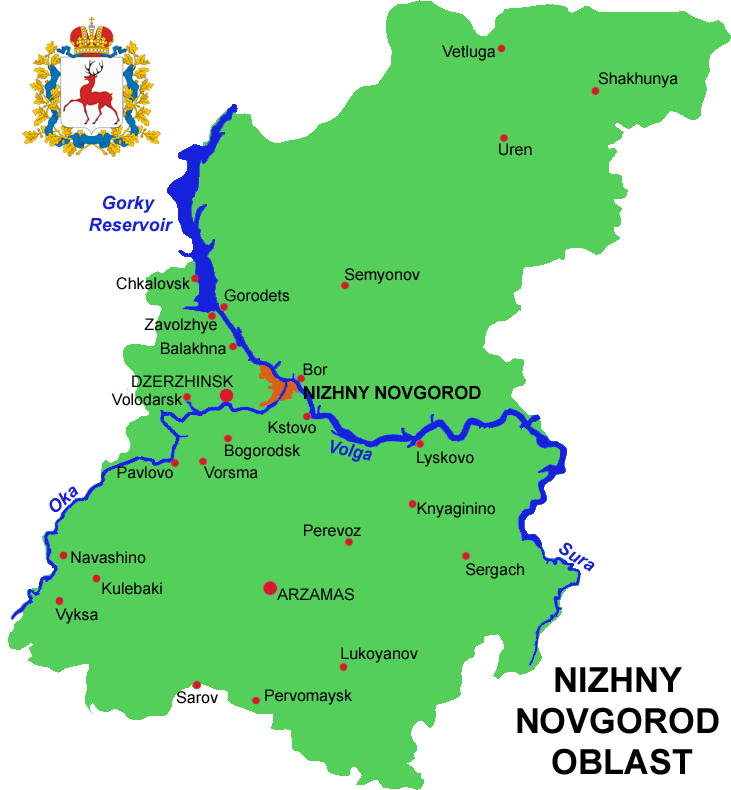|
Narrow Gauge Railway Of Decor-1 Factory
The Decor-1 factory railway is in the Nizhny Novgorod Oblast, Russia. The railway was opened in 1946, and has a total length of its track gauge is . The railway is used for the transportation of gypsum from the mine to the «Dekor-1» factory. Current status Peshelan gypsum factory «Dekor-1» located near the town of Arzamas, Nizhny Novgorod Oblast. In 1946 a gypsum mine was opened in the village of Bebyayevo. Ten trains run on the railway each day. Rolling stock Locomotives * TU6A – № 1473, 2574 * TU8 – № 0340, 0342 * Traction rolling stock in the mine – electric Railroad car * Snow blower * Minecart for transportation of gypsum Gallery Pechelan2.jpg, TU8 – № 0340 (2007) Pechelan1.jpg, TU8 – № 0340 (2007) Pechelan3.jpg, TU8 – № 0340 (2007) Decor-1 factory railway TU8-0342 with freight train.jpg, TU8 – № 0342 (2014) The train - panoramio.jpg, TU6 – № 2574 (2012) Bebyaevo, Nizhegorodskaya oblast', Russia - panoramio (31).jpg, ... [...More Info...] [...Related Items...] OR: [Wikipedia] [Google] [Baidu] |
Narrow-gauge Railway
A narrow-gauge railway (narrow-gauge railroad in the US) is a railway with a track gauge narrower than standard-gauge railway, standard . Most narrow-gauge railways are between and . Since narrow-gauge railways are usually built with Minimum railway curve radius, tighter curves, smaller structure gauges, and lighter rails, they can be less costly to build, equip, and operate than standard- or broad-gauge railways (particularly in mountainous or difficult terrain). Lower-cost narrow-gauge railways are often used in mountainous terrain, where engineering savings can be substantial. Lower-cost narrow-gauge railways are often built to serve industries as well as sparsely populated communities where the traffic potential would not justify the cost of a standard- or broad-gauge line. Narrow-gauge railways have specialised use in mines and other environments where a small structure gauge necessitates a small loading gauge. In some countries, narrow gauge is the standard; Japan, Indone ... [...More Info...] [...Related Items...] OR: [Wikipedia] [Google] [Baidu] |
Mantrip
An underground personnel carrier is any heavy duty vehicle designed specifically for the safe transport of personnel and their supplies into underground work areas. The most common underground applications is for the mining of either precious metal or coal. Types Narrow vein applications ; 5- and 7- man personnel carrier Where tight turning in confined spaces is necessary, personnel carriers designed on tractors are common. Heavy duty fenders, bumpers and man baskets (gondolas) are fabricated to mount on the tractor or tractor frames to provide more durability. ; Front loader personnel carrier These personnel carriers use a front loader to perform various loader applications. Also a front basket is typically attached to the front loader arms so that they may be lifted. These carriers are typically built to carry 5 or 7 men. ; Towing personnel carriers Some personnel carriers use a heavy duty hydraulic rear hitch that can two various attachments. Towing PCs can be used i ... [...More Info...] [...Related Items...] OR: [Wikipedia] [Google] [Baidu] |
Pizhemskaya Narrow Gauge Railway
The Pizhemskaya narrow gauge railway (''russian: link=no, Пижменская узкоколейная железная дорога, Pizhemskaya uzkokoleynaya zheleznaya doroga'') is a narrow-gauge railway in Nizhny Novgorod Oblast, Russia, built as an industrial railway ( forest railway) for logging operations. The forest railway was opened in 1926, has a total length of and is operational as of 2017, the track gauge is and operates year-round. Current status Planning for the railway and building began in 1926. The Pizhemskaya logging railway's first line was constructed in 1926, in the area of Tonshayevsky District in Nizhny Novgorod Oblast from the village Pizhma. The total length of the Pizhemskaya narrow-gauge railway at the peak of its development exceeded , of which is currently operational. The railway operates scheduled freight services from Pizhma, used for forestry tasks such as the transportation of felled logs and forestry workers. In 2017, repairs are being ... [...More Info...] [...Related Items...] OR: [Wikipedia] [Google] [Baidu] |
Kerzhenets Peat Narrow-gauge Railway
The Kerzhenets peat railway is located in Nizhny Novgorod Oblast, Russia. The peat railway was opened in 1945, and has a total length of ; the track gauge is . The railway operates year-round. Current status The Kerzhenets peat railway emerged in the 1940s, in the area of Borsky District, Nizhny Novgorod Oblast. The peat railway was built for hauling peat and workers. The railway line leaves Kerzhenets at northern side to reach the peat fields. Until 1997 the settlement Pionersky at Kerzhenets River was the terminus of the railway. A peat briquette factory was established in 2002 and started its work in 2004. Rolling stock Locomotives * TU8 – №0307 * ESU2A – №925 Railroad car * Flatcar * Tank car * Snow blower * Crane (railroad) * Open wagon Gallery File:Peat Briquette Factory.jpg, File:Briquette Factory Peat.jpg, File:Kerzhenets Peat Briquette Factory.jpg, File:Kerzhenets_peat_railway.JPG, See also *Narrow-gauge railways in Russia * Altsevo peat rail ... [...More Info...] [...Related Items...] OR: [Wikipedia] [Google] [Baidu] |
Altsevo Peat Narrow-gauge Railway
The Altsevo peat railway is located in Nizhny Novgorod Oblast, Russia. The peat railway was opened in 1962, and has a total length of and a track gauge of . Current status The Altsevo peat railway was constructed in 1962 in the Tonshayevsky District, and runs from the village of Pizhma to the swamp "Altsovsky Moss". The railway was built for hauling peat and workers and operates year-round with several pairs of trains a day. A peat briquette factory was built and put into operation in 2005. Rolling stock Locomotives * TU6A - No. 0310 * TU8 - No.*** *ESU2A - No. 671 * TD-5U "Pioneer" - Transportation local residents Railroad car * Flat wagon *Tank wagon *Snowplow * Crane (rail) *Tank wagon - fire train *Passenger car (rail) * Track laying cranes *Open wagon for peat * Hopper wagon to transport track ballast Gallery File:Altsevo peat4.JPG, Narrow-gauge railway File:Altsevo peat2.JPG, Tank wagon File:Altsevo peat5.JPG, Open wagon for peat File:Altsevo peat8.JPG, Open wa ... [...More Info...] [...Related Items...] OR: [Wikipedia] [Google] [Baidu] |
Narrow-gauge Railways In Russia
The Imperial Russian narrow railway track gauge was , the current track gauge is predominantly . In Soviet Russia, narrow-gauge railways were mostly common in forestry and peat industries in low inhabited places. Usually they have one main line and number of temporary branches. There was commonly a passenger service to villages and towns for workers. As of the mid 2010s, a number of industrial railways survive in places with bad roads, but every year some railways are closing. A government railway operator, RZD, closed all owned common 750 mm railways, but still have a number of children's railways with standard rolling stock. The most well-known narrow-gauge railways are Alapayevsk narrow-gauge railway (municipal passenger), Apsheronsk narrow-gauge railway (mountain industrial railway with passenger service), and Karinskaya narrow-gauge railway (suburban passenger private railway). Also children's railways are located in many big cities. Overview 1067mm * Sakhali ... [...More Info...] [...Related Items...] OR: [Wikipedia] [Google] [Baidu] |
Minecart
A minecart or mine cart (also known as a mine trolley or mine hutch) is a type of rolling stock found on a mine railway, used for moving ore and materials procured in the process of traditional mining. Minecarts are seldom used in modern operations, having largely been superseded in underground operations (especially coal mines) by more efficient belt conveyor systems that allow machines such as longwall shearers and continuous miners to operate at their full capacity, and above ground by large dumpers. Terminology Throughout the world, there are different titles for mine carts. In South Africa, a minecart is referred to as a ; in German, it is called (alternative spelling ). In Wales, minecarts are known as drams. In the U.S. and elsewhere, the term skip – or skip wagon (older spelling: ''waggon'') – is used. (See: Skip (container)#Etymology) In particular, a V skip wagon is a side-tipping skid with a V-shaped body. (Images) Design and operation Minecarts range in ... [...More Info...] [...Related Items...] OR: [Wikipedia] [Google] [Baidu] |
Snow Blower
A snow blower or snow thrower is a machine for removing snow from an area where it is problematic, such as a driveway, sidewalk, roadway, railroad track, ice rink, or runway. The commonly used term "snow blower" is a misnomer, as the snow is moved using an auger or impeller instead of being blown (by air). It can use either electric power (line power or battery), or a gasoline or diesel engine to throw snow to another location or into a truck to be hauled away. This is in contrast with the action of snow plows, which push snow to the front or side. Typically, the snow is discharged to one side. Snow blowers range from the very small, capable of removing only a few inches (a few more cm) of light snow in an path, to the very large, mounted onto heavy-duty winter service vehicles and capable of moving wide, or wider, swaths of heavy snow up to deep. Snow blowers can generally be divided into two classes: single-stage and two-stage. On a single-stage snow blower, the auger ... [...More Info...] [...Related Items...] OR: [Wikipedia] [Google] [Baidu] |
TU8 Diesel Locomotive
TU8 () – Soviet, later Russian diesel locomotive for gauge . History Diesel locomotive TU8 () is used for transportation & shunting services on narrow-gauge railways with a track gauge ranging from to . The TU8 was developed in 1987 – 1988 at the Kambarka Engineering Works to replace the ageing locomotive classes TU6A (). The cab is equipped with efficient heat-system, refrigerator, radio-set and air conditioning. Series locomotives The diesel locomotive TU8 (ТУ8) has been used as the basis of three other locomotives: * TU8G (ТУ8Г) * TU8P (ТУ8П) * TU6SPA (ТУ6СПА) mobile power station Additional specifications *Distance between bogies – 4,000 mm *Base of bogies – 1,400 mm Gallery File:Kud-134310.jpg, TU8, Udimskaya narrow-gauge railway File:Узкоколейный тепловоз ТУ8-0427 с туристическим поездом на станции Гуамка..JPG, TU8-0427, Apsheronsk narrow-gauge railway File:Sharya TU8-0167 w ... [...More Info...] [...Related Items...] OR: [Wikipedia] [Google] [Baidu] |
Nizhny Novgorod Oblast
Nizhny Novgorod Oblast (russian: link=no, Нижегородская область, ''Nizhegorodskaya oblast''), is a federal subjects of Russia, federal subject of Russia (an oblast). Its administrative center is the types of inhabited localities in Russia, city of Nizhny Novgorod. It has a population of 3,310,597 as of the Russian Census (2010), 2010 Census. From 1932 to 1990 it was known as Gorky Oblast. The oblast is crossed by the Volga River. Apart from Nizhny Novgorod's metropolitan area (including Dzerzhinsk, Russia, Dzerzhinsk, Bor, Nizhny Novgorod Oblast, Bor and Kstovo) the biggest city is Arzamas. Near the town of Sarov there is the Serafimo-Diveyevsky Monastery, one of the largest convents in Russia, established by Seraphim of Sarov, Saint Seraphim of Sarov. The Makaryev Monastery opposite of the town of Lyskovo, Nizhny Novgorod Oblast, Lyskovo used to be the location of the largest fair in Eastern Europe. Other historic towns include Gorodets, Nizhny Novgorod Oblast ... [...More Info...] [...Related Items...] OR: [Wikipedia] [Google] [Baidu] |




